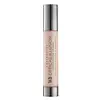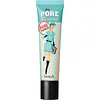Urban Decay Optical Illusion Complexion Primer Versus Benefit Cosmetics The POREfessional Face Primer
What's inside
What's inside
 Key Ingredients
Key Ingredients

 Benefits
Benefits

No benefits
 Concerns
Concerns

 Ingredients Side-by-side
Ingredients Side-by-side

Cyclopentasiloxane
EmollientDimethicone Crosspolymer
Emulsion StabilisingDimethicone/Vinyl Dimethicone Crosspolymer
Skin ConditioningSilica
AbrasiveEthylhexyl Hydroxystearate Benzoate
EmollientGlycerin
HumectantArgania Spinosa Kernel Oil
EmollientRosa Canina Fruit Oil
EmollientLimnanthes Alba Seed Oil
Skin ConditioningPolyglyceryl-3 Diisostearate
EmulsifyingDimethiconol
EmollientTriethoxycaprylylsilane
Glyceryl Caprylate
EmollientTocopheryl Acetate
AntioxidantWater
Skin ConditioningHydroxyapatite
AbrasiveSodium Olivoyl Glutamate
CleansingPhenoxyethanol
PreservativePropylene Glycol
HumectantCaprylyl Glycol
EmollientEthylhexylglycerin
Skin ConditioningMica
Cosmetic ColorantCI 77891
Cosmetic ColorantCI 77491
Cosmetic ColorantCyclopentasiloxane, Dimethicone Crosspolymer, Dimethicone/Vinyl Dimethicone Crosspolymer, Silica, Ethylhexyl Hydroxystearate Benzoate, Glycerin, Argania Spinosa Kernel Oil, Rosa Canina Fruit Oil, Limnanthes Alba Seed Oil, Polyglyceryl-3 Diisostearate, Dimethiconol, Triethoxycaprylylsilane, Glyceryl Caprylate, Tocopheryl Acetate, Water, Hydroxyapatite, Sodium Olivoyl Glutamate, Phenoxyethanol, Propylene Glycol, Caprylyl Glycol, Ethylhexylglycerin, Mica, CI 77891, CI 77491
Cyclopentasiloxane
EmollientDimethicone
EmollientDimethicone/Vinyl Dimethicone Crosspolymer
Skin ConditioningIsononyl Isononanoate
EmollientSilica
AbrasiveDimethicone Crosspolymer
Emulsion StabilisingIsododecane
EmollientPhenoxyethanol
PreservativePolymethyl Methacrylate
CI 77891
Cosmetic ColorantCyclohexasiloxane
EmollientTocopheryl Acetate
AntioxidantParfum
MaskingMica
Cosmetic ColorantCI 77492
Cosmetic ColorantLimonene
PerfumingCI 77491
Cosmetic ColorantCI 77499
Cosmetic ColorantTriethoxycaprylylsilane
BHT
AntioxidantCyclopentasiloxane, Dimethicone, Dimethicone/Vinyl Dimethicone Crosspolymer, Isononyl Isononanoate, Silica, Dimethicone Crosspolymer, Isododecane, Phenoxyethanol, Polymethyl Methacrylate, CI 77891, Cyclohexasiloxane, Tocopheryl Acetate, Parfum, Mica, CI 77492, Limonene, CI 77491, CI 77499, Triethoxycaprylylsilane, BHT
 Reviews
Reviews

Ingredients Explained
These ingredients are found in both products.
Ingredients higher up in an ingredient list are typically present in a larger amount.
Ci 77491 is also hydrated iron III oxide. It's sole purpose is to give a red/pink hue to products.
Iron III oxides are classified as inorganic chemicals for coloring.
Synthetically created Ci 77491 is considered safer than those naturally found. This is because the synthetically created version may contain less impurities. Iron oxides are generally non-toxic and non-allergenic.
Learn more about CI 77491Ci 77891 is a white pigment from Titanium dioxide. It is naturally found in minerals such as rutile and ilmenite.
It's main function is to add a white color to cosmetics. It can also be mixed with other colors to create different shades.
Ci 77891 is commonly found in sunscreens due to its ability to block UV rays.
Learn more about CI 77891Cyclopentasiloxane, or D5, is a silicone used to improve texture of products and trap moisture.
D5 is considered lightweight and volatile. Volatile means it evaporates quickly after application. Once evaporated, D5 leaves a thin barrier that helps keep skin hydrated.
It is also an emollient. Emollients help soften the skin and prevent water loss. Silicones create a silky texture in products. D5 helps other ingredients become more spreadable.
Studies show D5 is safe to use in skincare products. We recommend speaking with a skincare professional if you have concerns.
Learn more about CyclopentasiloxaneDimethicone Crosspolymer is a silicone created by modifying dimethicone with hydrocarbon side chains. Due to its large size, it does not penetrate skin. It is considered non-occlusive.
Dimethicone Crosspolymer is used to stabilize and thicken products. It also helps give products a silky feel.
This ingredient is a silicone used to improve the texture of products and absorb oil. It does not get absorbed into the skin.
Like other silicones, Dimethicone/Vinyl Dimethicone Crosspolymer helps condition the skin by creating a barrier. In this sense, it can act as an emollient and trap moisture in.
This ingredient is a type of elastomer.
Learn more about Dimethicone/Vinyl Dimethicone CrosspolymerMica is a naturally occurring mineral used to add shimmer and color in cosmetics. It can also help improve the texture of a product or give it an opaque, white/silver color.
Serecite is the name for very fine but ragged grains of mica.
This ingredient is often coated with metal oxides like titanium dioxide. Trace amounts of heavy metals may be found in mica, but these metals are not harmful in our personal products.
Mica has been used since prehistoric times throughout the world. Ancient Egyptian, Indian, Greek, Roman, Aztec, and Chinese civilizations have used mica.
Learn more about MicaPhenoxyethanol is a preservative that has germicide, antimicrobial, and aromatic properties. Studies show that phenoxyethanol can prevent microbial growth. By itself, it has a scent that is similar to that of a rose.
It's often used in formulations along with Caprylyl Glycol to preserve the shelf life of products.
Silica, also known as silicon dioxide, is a naturally occurring mineral. It is used as a fine, spherical, and porous powder in cosmetics.
Though it has exfoliant properties, the function of silica varies depending on the product.
The unique structure of silica enhances the spreadability and adds smoothness, making it a great texture enhancer.
It is also used as an active carrier, emulsifier, and mattifier due to its ability to absorb excess oil.
In some products, tiny microneedles called spicules are made from silica or hydrolyzed sponge. When you rub them in, they lightly polish away dead skin layers and enhance the penetration of active ingredients.
Learn more about SilicaTocopheryl Acetate is AKA Vitamin E. It is an antioxidant and protects your skin from free radicals. Free radicals damage the skin by breaking down collagen.
One study found using Tocopheryl Acetate with Vitamin C decreased the number of sunburned cells.
Tocopheryl Acetate is commonly found in both skincare and dietary supplements.
Learn more about Tocopheryl AcetateTriethoxycaprylylsilane is a silicone used to bind and stabilize ingredients.
As an emulsifier, it helps prevent ingredients from separating. This can help elongate the shelf life of products.
Triethoxycaprylylsilane is often used to coat mineral sunscreens ingredients to help give a better feel. It also helps reduce oxidative stress in sunscreens.
Learn more about Triethoxycaprylylsilane